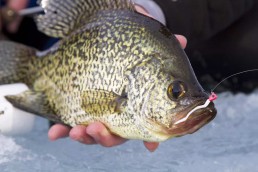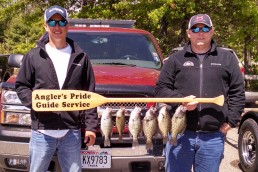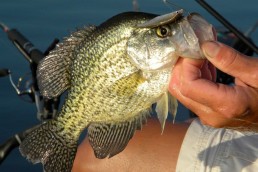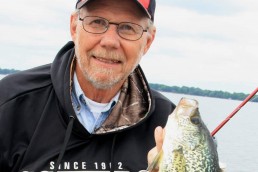Contact Crappies
SHARE THIS POST
So many first-ice crappie locations can be predictable. Troughs, dips, channels and holes seem to concentrate crappies in the fall, and these areas generally seem to hold them into the winter. Over basins, in particular, these fish can often be found suspended in the water column. Some of these locations can be several acres while some can be the size of half a tennis court, or smaller.
On many natural lakes and some reservoirs, these locations can often be big. When first-ice crappies are relating to “big” locations that can seem like a daunting abyss, there are many strategies that you can use to up the odds of finding and catching these fish.
Besides the intimidating size of the wintering locations crappies slide into during winter, what can also make these fish difficult to find is how they school. Larger basins will often see fish scattered in packs. These wolf packs of crappies move in tight vertical schools, about the speed of a slow-walk, which is moving pretty fast when you are trying to keep up with them with a 6-inch auger. You can literally have 10 or more fish underneath you on the Vexilar and a friend 15 feet away might not see a fish. These vertical schools of fish indeed move fast and are fleeting.
This situation creates a feast-or-famine environment where you might drill several holes and not mark any signs of life and then suddenly have 15 feet of fish below you that can seem to disappear like smoke. So often, the reality is that most of the time we are dropping transducers down holes where there are no fish and then we trust the Vexilar in that we don’t actually “fish” until we mark the fish. Many species get caught in these shorter intense windows where you might catch four fish out of a hole before you loose them. You then have to keep moving to either catch up with the fish you just caught or find a new school.
Up the odds
Most holes or basins have features that just seem to funnel or concentrate the fish. While they can be roaming a large area, there are often key locations to focus on particularly before fishing pressure changes the dynamics of a location at early ice.
Most of the best locations seem to range between 10 to 30 feet on many lakes and are at least 5 feet deeper than the surrounding water. When looking at these deeper-basin locations, look for inside turns and necked-down areas that corner roaming fish. Points or outside turns can also be sweet spots. And, a stretch with a sharper breaking contour is also always worth checking. Even though the hole or trough itself might be featureless across the basin, the edges of the hole often point to where one should fish.
Tag team
If there were ever a situation where fishing with a team of like-minded anglers can increase your success on the ice, suspended crappies over basins would be one. When in a search-and-hunt mode, spread out and cover water, but when you find fish, be efficient and try to land them together. While finding these fish can create a challenge, maximizing efficiency is important. And by fishing together, you can keep your potential catch around longer because somebody has a line in the water and a lure down below, keeping fish from drifting off. When you are alone you may lose fish because the school can drift off as you’re busy unhooking a tricky fish and trying to get back down.
Managing the school
Some of the best panfish anglers are masters at managing a school. The first task is to lift the school with your presentation as much as possible. When they are aggressive, it’s not uncommon to lift the fish 10 feet or more. By lifting the school and causing the fish to rise up, you can often separate the larger ones from the smaller ones in a pack because the larger fish are often more dominant and faster.
Are you enjoying this post?
You can be among the first to get the latest info on where to go, what to use and how to use it!
Don’t drop down into the pack unless you have to and fish down to them, seeing if they’ll shoot up. Whenever possible, pull fish off the top of the school, as it seems to disrupt the remaining fish less than dropping down through them and pulling fish up from the bottom.
The spectrum of profiles
Because lifting the fish is so important when targeting basin-running crappies, I often start out using larger profiles whether I’m using tungsten jigs, spoons or swim lures. Larger profiles can shine over this open water because fish can see them farther away, which helps you find the fish, and they can also lift or separate the more aggressive fish from the rest of the pack. Start out with the “dinner bell” that can be seen.
When the attitude of the fish changes either from a result of the time of day or because the schools have been picked apart where fish no longer accelerate up for a presentation, that is then the time to throw a second rod down. After you catch the easy, aggressive fish, clean up the stragglers with a smaller, more finesse-type of presentation by simply downsizing to a smaller tungsten jig that is rigged with a smaller, more delicate soft plastic.
Understanding the location
Once you find the fish and get in the zone, your moves become much smaller. You have successfully broken down a large area to find the sweet spot where there is some activity. As you hop from hole to hole, you sometimes stay on the same school of fish, but you are also landing on new ones that are cruising around the same area. What so often happens is that we end up finding a handful of holes and rotate through the holes until we quit seeing the fish. Often, these fish just seem to roll around the area and if you were to have the patience to sit over one hole, they’ll probably roll back through at some point after they initially leave.
You’ll usually catch more if you can bounce around and not fish until you mark them. Crappies make a good solid return on your electronics so if they’re below; you are going to see them so walk from hole to hole and trust your electronics. To see more when targeting suspended schools, turn your gain up slightly and rock the transducer from one side of the hole to the other. This increases the amount of water you’re looking at. And if the screen lights up when you swing the transducer to one side of the hole, they’re close and just to the edge of the cone angle.
Jason Mitchell is a top walleye guide on Devils Lake, N.D. He is the host for the outdoor program, “Jason Mitchell Outdoors.” Visit jasonmitchelloutdoors.com for more.
MWO
SHARE THIS POST
Did you enjoy this post?
You can be among the first to get the latest info on where to go, what to use and how to use it!
Jason Mitchell
Jason Mitchell was a top walleye guide on Devils Lake, N.D. for nearly 20 years. Today, Mitchell produces the Jason Mitchell Outdoors TV program. Visit jasonmitchelloutdoors.com for more.




